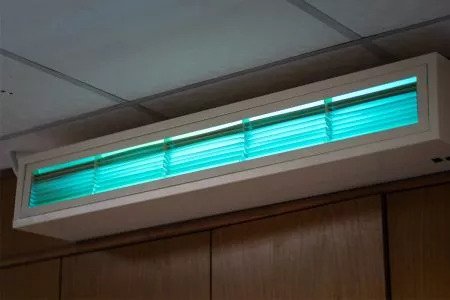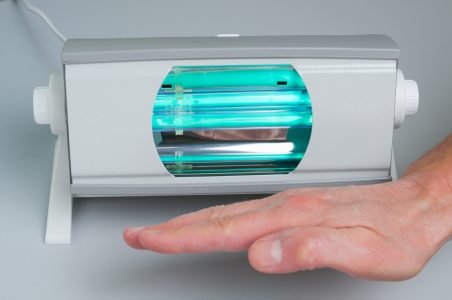Excimer lamps are ultraviolet lamps that are designed to emit UV wavelengths in the range of approximately 170 nanometers (nm) to 230 nm, dependent upon noble gas excimers present. Excimer lamps are useful in many applications, such as UVC sterilization, ozone generation, and UV curing processes.
What is an Excimer Lamp?
Excimer is a term that refers to a temporary atomic state where high-energy atoms create short-lived molecular pairs, or dimers, when electronically excited.
Excimer refers to a transient atomic state in which electronically excited high-energy atoms create short-lived molecular partners or dimers. UVC photons are released as excited dimers, excimers, return to their original state. The term excimer refers specifically to homodimeric bonds, a bond between the same species of molecules such as xenon (Xe). A xenon excimer lamp uses Xe atoms to form excited Xe2 dimers, which result in UV photons emitted at the 172 nm wavelength.
Heterodimeric bonds (bonds from two different structural species), has the official term of an exciplex. An example of an exciplex is the bond with Krypton-chloride (KrCl), which is an exciplex that emits wavelengths in the range of 222 nm. 222 nm UV light is recognized for high antimicrobial capabilities and is also referred to as Far UVC.
Excimer lamps are the generally accepted term for lamps that emit both excimer and exciplex radiation in the range of 172 nm and 222 nm, respectively.
How Do Excimer Lamps Work?
Excimer lamps irradiate the desired UV wavelength in the vacuum ultraviolet (VUV) range (between 100 – 200 nm) in a specialty coated, sealed quartz glass chamber with noble gases. An intense plasma discharge also called a dielectric barrier discharge, is generated from the high-energy electrons. The atomic excitement of noble gases is induced by the plasma, which triggers the creation of excited dimers, or excimers. The Excimer-specific UV radiation results during the final emission stage when Excimer molecules disassociate and return to their original state, all of this occurring in nanoseconds.
Excimer Lamp Application Uses
Excimer lamps are ideal in many applications and are gaining significant attention with the ability to disinfect surfaces with the same efficacy as traditional 254 nm UV lamps without the risk of human exposure.
Excimer Lamps for Sterilization, 222 nm
Excimer lamps designed to emit 222 nm radiation, also called Far UVC lamps, are increasing in use for sterilization applications worldwide with the same germicidal effectiveness as traditional 254 nm lamps and can be used in the presence of humans. In one study published at the National Library of Medicine, the effects of 222 nm UVC light for disinfection and healing effects were shown to be effective on methicillin-resistant Staphylococcus aureus infection in mouse wounds without damaging DNA.
Both 222 nm lamps and 254 conventional low-pressure mercury lamps were used in this study. 222 nm UVC light significantly reduced bacterial count on mice skin wounds infected with methicillin-resistant Staphylococcus aureus (MRSA). When compared with the effectiveness on days 3, 5, 8, and 12, irradiation of bacterial counts with 222 nm UV light was the same as or even more effective than 254 nm radiation.
Sterilization and Safety
While 254 nm UVC germicidal lamps have been used for decades and are highly effective at eliminating the risk of infection from many viruses, bacteria, and harmful pathogens, exposure to this wavelength is harmful to humans. 254 nm UV radiation causes DNA lesions such as cyclobutane pyrimidine dimers (CPD) in human cells. Long-term repeated exposure can cause skin cancer and eye damage.
Short wave, 222 nm UV light, is absorbed by the proteins in the membrane and therefore does not reach the nucleus of human cells. This same study evaluated the safety of 222 nm excimer lamps vs 254 nm conventional germicidal lamps and found that immediately after irradiation, the epidermis irradiated with 254 nm light showed the presence of CPD expressing cells but was not present after irradiation with 222 nm UVC. Excimer lamps emitting 222 nm light are proving to provide highly effective sterilization combined with human biological safety.
Excimer lamps have other uses in addition to sterilization, and not all Excimer lamps are far UVC lamps.
Excimer Lamps for Surface Activation, 172 nm
Alteration of surface energy is required in many industrial applications for surface treatments, such as applying coatings and adhesives to substrates. 172 nm lamps are an excellent choice for surface modification and provide additional benefits of cleaning and activating substrate surfaces simultaneously. 172 nm provides powerful electromagnetic energy to directly crack major bonds in organic molecules without altering any physical surface properties.
Excimer lamps designed to emit 172 nm increase the wettability and surface energy of various substrates such as glass, metals, and polymers. Surface energy is measured in millinewtons per metre (mN/m), with 172 nm excimer lamps meeting surface activation energy requirements for solvent inks, UV inks, water-based systems, and coatings. Excimer lamp technology provides many benefits to UV curing applications, including cleaning, bonding, and coating.
Surface Activation Alternative Treatment
172 nm Excimer lamps are a good alternative to plasma and Corona-based surface treatments with considerably less excess heat and reduced thermal load. Both plasma and Corona are electrical discharge surface activation methods. Excimer lamps
provide effective surface activation without damage to surface structure, resulting in better results for bonding.
Ozone Production with Excimer Lamps, 185 Nm
Excimer lamps are also effective at producing ozone, a natural oxidizer, odor reducer, and disinfectant effective in air and water sterilization applications. Ozone is typically produced at 185 nm standard low-pressure mercury lamps, although Excimer lamps filled with xenon are an efficient source to generate ozone with no nitrogen oxides (NOx) as the UV radiation is not high enough to excite nitrogen in the air.
Excimer lamps are proving to be a very exciting development and an increasingly promising offering in the UV lamp market.
LightSources is currently in the development of Excimer lamps, and we offer a wide selection of UVC germicidal lamps used in surface, water, and air sterilization systems worldwide. We design, engineer, and manufacture UVC germicidal lamps, UV curing lamps for surface treatment applications, as well as ozone-producing lamps.
What is an Excimer Lamp?
Excimer is a term that refers to a temporary atomic state where high-energy atoms create short-lived molecular pairs, or dimers, when electronically excited.
Excimer refers to a transient atomic state in which electronically excited high-energy atoms create short-lived molecular partners or dimers. UVC photons are released as excited dimers, excimers, return to their original state. The term excimer refers specifically to homodimeric bonds, a bond between the same species of molecules such as xenon (Xe). A xenon excimer lamp uses Xe atoms to form excited Xe2 dimers, which result in UV photons emitted at the 172 nm wavelength.
Heterodimeric bonds (bonds from two different structural species), has the official term of an exciplex. An example of an exciplex is the bond with Krypton-chloride (KrCl), which is an exciplex that emits wavelengths in the range of 222 nm. 222 nm UV light is recognized for high antimicrobial capabilities and is also referred to as Far UVC.
Excimer lamps are the generally accepted term for lamps that emit both excimer and exciplex radiation in the range of 172 nm and 222 nm, respectively.
How Do Excimer Lamps Work?
Excimer lamps irradiate the desired UV wavelength in the vacuum ultraviolet (VUV) range (between 100 – 200 nm) in a specialty coated, sealed quartz glass chamber with noble gases. An intense plasma discharge also called a dielectric barrier discharge, is generated from the high-energy electrons. The atomic excitement of noble gases is induced by the plasma, which triggers the creation of excited dimers, or excimers. The Excimer-specific UV radiation results during the final emission stage when Excimer molecules disassociate and return to their original state, all of this occurring in nanoseconds.
Excimer Lamp Application Uses
Excimer lamps are ideal in many applications and are gaining significant attention with the ability to disinfect surfaces with the same efficacy as traditional 254 nm UV lamps without the risk of human exposure.
Excimer Lamps for Sterilization, 222 nm
Excimer lamps designed to emit 222 nm radiation, also called Far UVC lamps, are increasing in use for sterilization applications worldwide with the same germicidal effectiveness as traditional 254 nm lamps and can be used in the presence of humans. In one study published at the National Library of Medicine, the effects of 222 nm UVC light for disinfection and healing effects were shown to be effective on methicillin-resistant Staphylococcus aureus infection in mouse wounds without damaging DNA.
Both 222 nm lamps and 254 conventional low-pressure mercury lamps were used in this study. 222 nm UVC light significantly reduced bacterial count on mice skin wounds infected with methicillin-resistant Staphylococcus aureus (MRSA). When compared with the effectiveness on days 3, 5, 8, and 12, irradiation of bacterial counts with 222 nm UV light was the same as or even more effective than 254 nm radiation.
Sterilization and Safety
While 254 nm UVC germicidal lamps have been used for decades and are highly effective at eliminating the risk of infection from many viruses, bacteria, and harmful pathogens, exposure to this wavelength is harmful to humans. 254 nm UV radiation causes DNA lesions such as cyclobutane pyrimidine dimers (CPD) in human cells. Long-term repeated exposure can cause skin cancer and eye damage.
Short wave, 222 nm UV light, is absorbed by the proteins in the membrane and therefore does not reach the nucleus of human cells. This same study evaluated the safety of 222 nm excimer lamps vs 254 nm conventional germicidal lamps and found that immediately after irradiation, the epidermis irradiated with 254 nm light showed the presence of CPD expressing cells but was not present after irradiation with 222 nm UVC. Excimer lamps emitting 222 nm light are proving to provide highly effective sterilization combined with human biological safety.
Excimer lamps have other uses in addition to sterilization, and not all Excimer lamps are far UVC lamps.
Excimer Lamps for Surface Activation, 172 nm
Alteration of surface energy is required in many industrial applications for surface treatments, such as applying coatings and adhesives to substrates. 172 nm lamps are an excellent choice for surface modification and provide additional benefits of cleaning and activating substrate surfaces simultaneously. 172 nm provides powerful electromagnetic energy to directly crack major bonds in organic molecules without altering any physical surface properties.
Excimer lamps designed to emit 172 nm increase the wettability and surface energy of various substrates such as glass, metals, and polymers. Surface energy is measured in millinewtons per metre (mN/m), with 172 nm excimer lamps meeting surface activation energy requirements for solvent inks, UV inks, water-based systems, and coatings. Excimer lamp technology provides many benefits to UV curing applications, including cleaning, bonding, and coating.
Surface Activation Alternative Treatment
172 nm Excimer lamps are a good alternative to plasma and Corona-based surface treatments with considerably less excess heat and reduced thermal load. Both plasma and Corona are electrical discharge surface activation methods. Excimer lamps
provide effective surface activation without damage to surface structure, resulting in better results for bonding.
Ozone Production with Excimer Lamps, 185 Nm
Excimer lamps are also effective at producing ozone, a natural oxidizer, odor reducer, and disinfectant effective in air and water sterilization applications. Ozone is typically produced at 185 nm standard low-pressure mercury lamps, although Excimer lamps filled with xenon are an efficient source to generate ozone with no nitrogen oxides (NOx) as the UV radiation is not high enough to excite nitrogen in the air.
Excimer lamps are proving to be a very exciting development and an increasingly promising offering in the UV lamp market.
LightSources is currently in the development of Excimer lamps, and we offer a wide selection of UVC germicidal lamps used in surface, water, and air sterilization systems worldwide. We design, engineer, and manufacture UVC germicidal lamps, UV curing lamps for surface treatment applications, as well as ozone-producing lamps.


